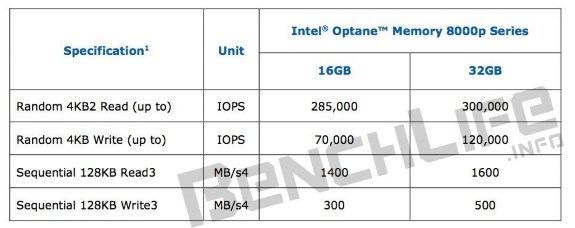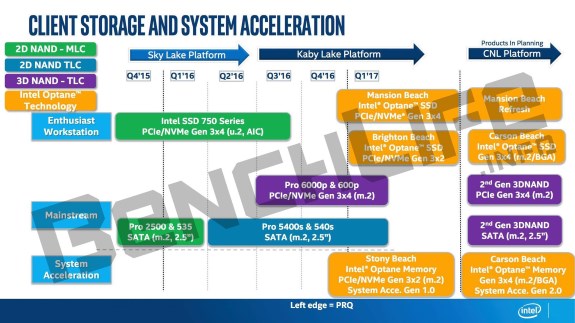These parts are codenamed "Stony Beach" and will be marketed as the Intel 8000p series. It's believed that you will need Intel's upcoming Kaby Lake platform to take advantage of Optane so that will likely limited the adoption rate. Furthermore, we're not quite sure if there's a large market for the 8000p series, it's sort of an intermediate caching solution between the PC's RAM and its storage.
The 8000p will use PCI Express 3.0 x2 via the M.2 form factor, there will be a 16GB model with 1400MB/s read speeds and 300MB/s write speeds, as well as a 32GB version with 1600MB/s read speeds and 400MB/s write speeds. In terms of random 4K IOPS, the 16GB model offers 285,000 read and 70,000 write, while the 32GB part offers 300,000 read and 120,000 write.
As TechPowerUp concludes, it doesn't look like much on paper but we have to take into account that this is still an early version of Optane. To fully leverage this technology, a new system interface will be necessary because PCI Express can't deliver enough bandwidth.
This in itself isn't much to talk about - the latest consumer-grade NAND-based SSD solutions already sport read and write speeds comparable to these Intel Optane drives (Samsung's 960 EVO springs to mind). That said, a product's performance can't be solely appraised by the way it looks on paper. As it is, the exact testing conditions that originated these performance ratings are unknown. More specifically, the metrics where 3D XPoint is supposed to excel versus NAND: latency access times, and speed at lower queue depths. And of course, one should not forget the lack of information on what amounts to the leading metric towards general consumer adoption: pricing.

A slide from earlier this year suggests Stony Beach will launch soon and the first real Optane SSDs may arrive shortly afterwards. Mansion Beach is expected towards the end of the year and Brighton Beach in early 2017. Both are aimed at the enthusiast and workstation market, Brighton Beach uses PCIe 3.0 x2 NVMe and Mansion Beach is PCIe 3.0 x4 NVMe.
